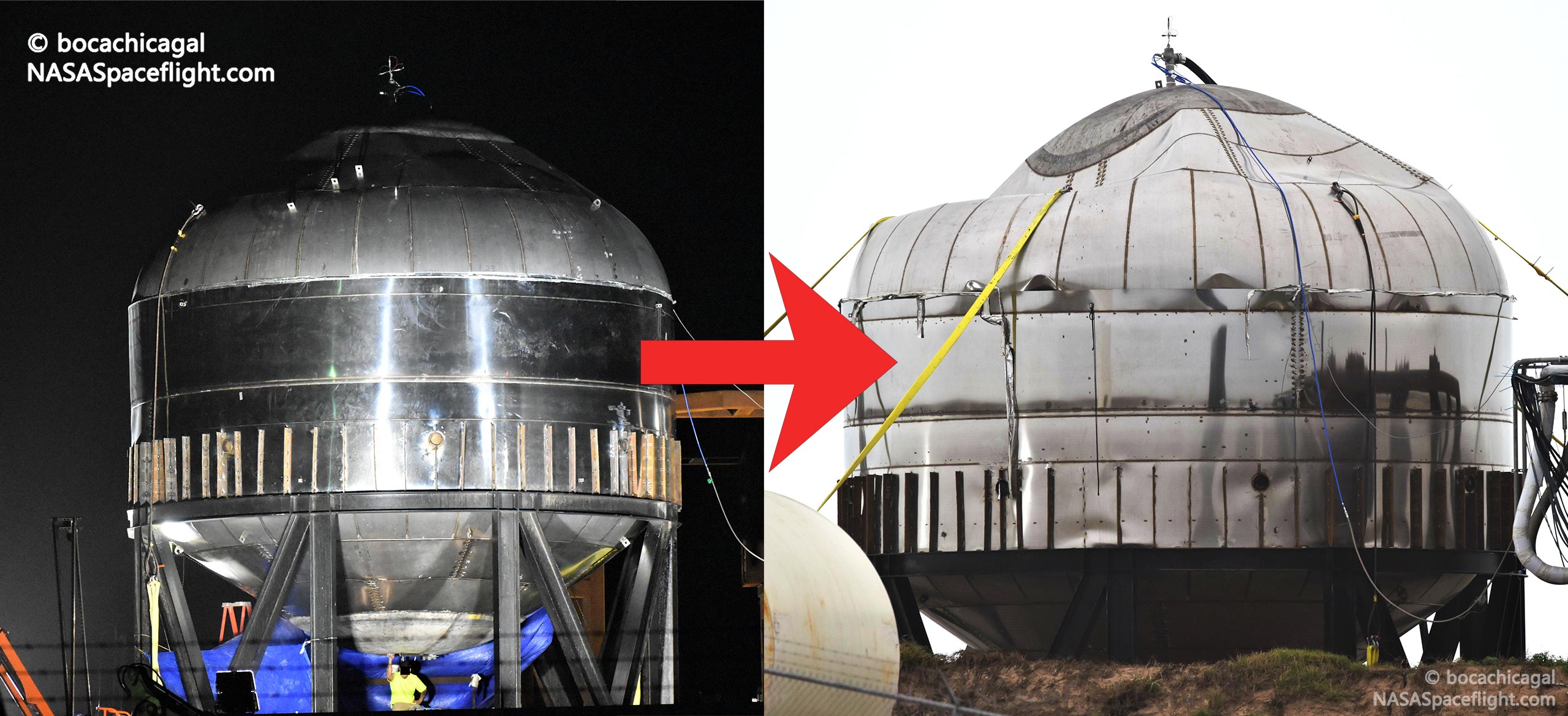
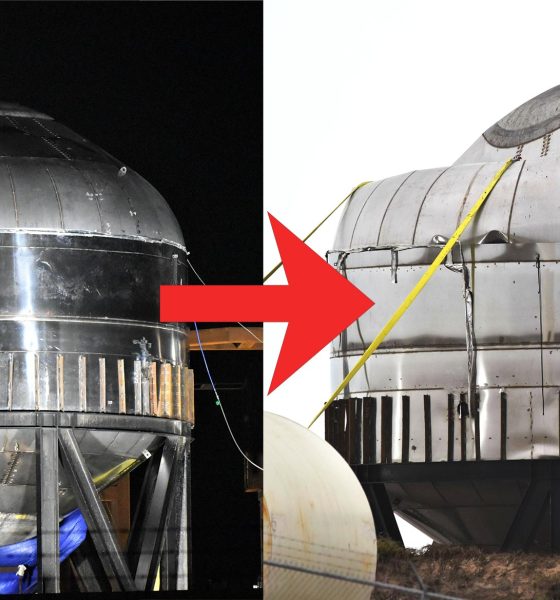
News
SpaceX just blew up a Starship tank on purpose and Elon Musk says the results are in
Before dawn on January 10th, SpaceX technicians and engineers intentionally blew up a miniature Starship tank in order to test recently-upgraded manufacturing and assembly methods, likely to be used to build the first Starships bound for flight tests and orbit.
SpaceX CEO Elon Musk quickly weighed in on Twitter later the same day, revealing some crucial details about the Starship tank test and effectively confirming that it was a success. While somewhat unintuitive, this is the second time SpaceX has intentionally destroyed largely completed Starship hardware in order to determine the limits of the company’s current methods of production and assembly.
Most notably, on November 20th, SpaceX is believed to have intentionally overpressurized the Starship Mk1 prototype in a very similar – albeit larger-scale – test, destroying the vehicle and sending its top tank dome flying hundreds of feet into the air. It’s generally believed that SpaceX (or perhaps even just Musk) decided that Starship Mk1 was not fit to fly, leading the company to switch gears and deem the prototype a “manufacturing pathfinder” rather than the first Starship to fly – which Musk had explicitly stated just a few months prior.
Bopper (Baby StarPopper) this morning after the overpressure event at SpaceX Boca Chica. ??@NASASpaceflight https://t.co/nCG7E9XtKM pic.twitter.com/PRTDQvvlRh— Mary (@BocaChicaGal) January 10, 2020
Dome to barrel weld made it to 7.1 bar, which is pretty good as ~6 bar is needed for orbital flight. With more precise parts & better welding conditions, we should reach ~8.5 bar, which is the 1.4 factor of safety needed for crewed flight.— Buff Mage (@elonmusk) January 10, 2020
Instead, Starship Mk1 suffered irreparable damage during its pressurization test and was rapidly scrapped in the weeks following, although several segments were thankfully salvaged – perhaps for use on future prototypes. Along those lines, it can arguably be said that the results from the mini Starship tank’s Jan. 10 pop test have paved the way for SpaceX to build the first truly flightworthy Starship prototypes – potentially all the way up to the first spaceworthy vehicles.
Hours after the test, Musk revealed that the Starship test tank failed almost exactly where and how SpaceX expected it would, bursting when the weld joining the upper dome and tank wall failed. Critically, the tank reached a maximum sustained pressure of 7.1 bar (103 psi), some 18% over the operating pressure (6 bar/87 psi) Musk says Starship prototypes will need to be declared fully capable of orbital test flights. In other words, given the tank’s size, it survived an incredible ~20,000 metric tons (45 million lbf) of force spread out over its surface area, equivalent to about 20% the weight of an entire US Navy aircraft carrier.
Musk also revealed that SpaceX will require Starships to survive a minimum of 140% of that operating pressure before the company will allow the spacecraft to launch humans.
Some have less than generously taken to smugly noting that several modern spaceflight and engineering standards require that launch vehicle tankage be rated to survive no less than 125% of their operating pressure, while this test tank would be rated for less than 118% under identical conditions. However, this ignores several significant points of interest. First and foremost, the Starship test tank intentionally destroyed on January 10th was assembled from almost nothing – going from first weld to a completed pressurization test – in less than three weeks (20 days).
Second, all visible welding and assembly work was performed outside in the South Texas elements with only a minor degree of protection from the coastal winds and environment. Although some obvious tweaks were made to the specific methods used to assembly the prototype tank, it also appears that most of the welding was done by hand. For the most part, in other words, the methods used to build this improved test article were largely unchanged compared to Starship Mk1, which is believed to have failed around 3-5 bar (40-75 psi).
Additionally, it appears that almost all aspects of this test tank have smaller structural margins, meaning that the tank walls and domes are likely using steel stock that is substantially thinner than what was used on Starship Mk1. Nevertheless, thanks to the addition of continuous (single-weld) steel rings, a tweaked dome layout, and slightly refined welding, this test tank has performed anywhere from 20% to 200+% better than Starship Mk1 – again, all while coming together from scratch in a period of less than three weeks.
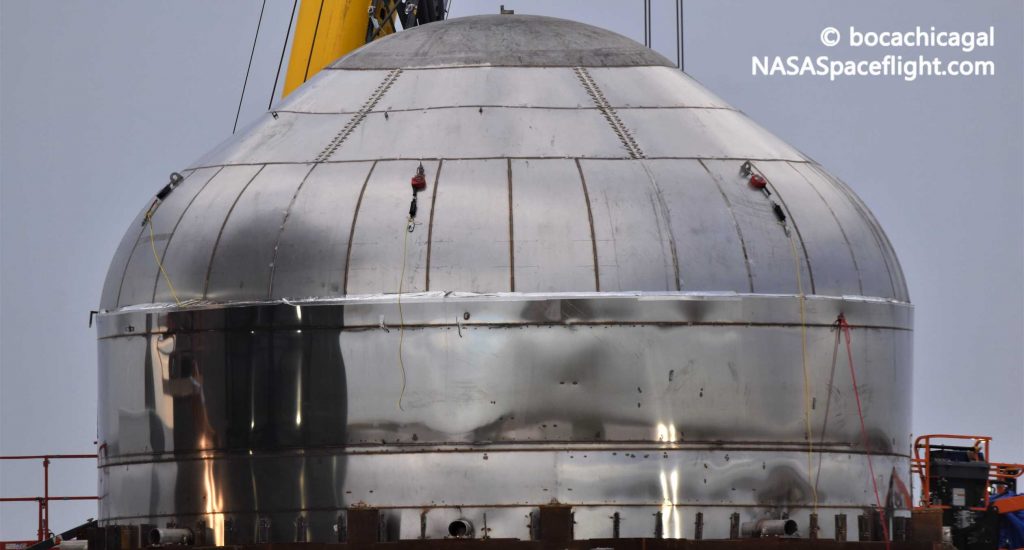
As Musk notes, with relatively minor improvements to welding conditions and the manufacturing precision of Starship rings and domes, SpaceX can likely ensure that Starships (and thus Super Heavy boosters) will be able to survive pressures greater than 8.5 bar (125 psi), thus guaranteeing a safety margin of at least 40%. Even a minor improvement of ~6% would give vehicles a safety margin of 125%, enough – in the eyes of engineering standards committees – to reasonably certify Starships for orbital test flights.
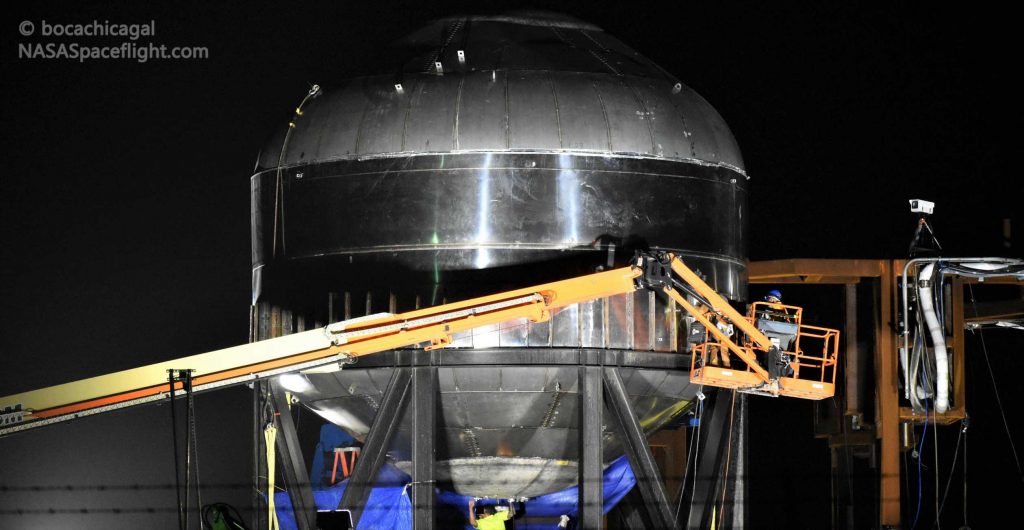
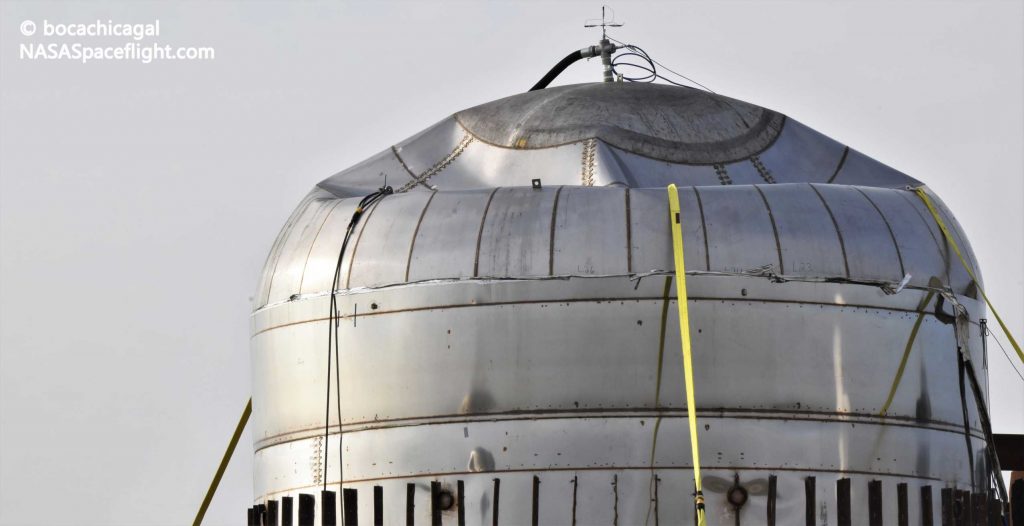
All things considered, it’s safe to assume that SpaceX is going to begin building and assembling Starship SN01 (formerly Mk3) hardware almost immediately. Given that this test tank took just 20 days to assemble, it’s safe to say that the upgraded prototype’s tank section could be completed in just a handful of weeks. Stay tuned for progress reports.
Check out Teslarati’s Marketplace! We offer Tesla accessories, including for the Tesla Cybertruck and Tesla Model 3.

News
Tesla aims to combat common Full Self-Driving problem with new patent
Tesla writes in the patent that its autonomous and semi-autonomous vehicles are heavily reliant on camera systems to navigate and interact with their environment.

Tesla is aiming to combat a common Full Self-Driving problem with a new patent.
One issue with Tesla’s vision-based approach is that sunlight glare can become a troublesome element of everyday travel. Full Self-Driving is certainly an amazing technology, but there are still things Tesla is aiming to figure out with its development.
Unfortunately, it is extremely difficult to get around this issue, and even humans need ways to combat it when they’re driving, as we commonly use sunglasses or sun visors to give us better visibility.
Cameras obviously do not have these ways to fight sunglare, but a new patent Tesla recently had published aims to fight this through a “glare shield.”
Tesla writes in the patent that its autonomous and semi-autonomous vehicles are heavily reliant on camera systems to navigate and interact with their environment.

The ability to see surroundings is crucial for accurate performance, and glare is one element of interference that has yet to be confronted.
Tesla described the patent, which will utilize “a textured surface composed of an array of micro-cones, or cone-shaped formations, which serve to scatter incident light in various directions, thereby reducing glare and improving camera vision.”

The patent was first spotted by Not a Tesla App.
The design of the micro-cones is the first element of the puzzle to fight the excess glare. The patent says they are “optimized in size, angle, and orientation to minimize Total Hemispherical Reflectance (THR) and reflection penalty, enhancing the camera’s ability to accurately interpret visual data.”
Additionally, there is an electromechanical system for dynamic orientation adjustment, which will allow the micro-cones to move based on the angle of external light sources.
This is not the only thing Tesla is mulling to resolve issues with sunlight glare, as it has also worked on two other ways to combat the problem. One thing the company has discussed is a direct photon count.
CEO Elon Musk said during the Q2 Earnings Call:
“We use an approach which is direct photon count. When you see a processed image, so the image that goes from the sort of photon counter — the silicon photon counter — that then goes through a digital signal processor or image signal processor, that’s normally what happens. And then the image that you see looks all washed out, because if you point the camera at the sun, the post-processing of the photon counting washes things out.”
Future Hardware iterations, like Hardware 5 and Hardware 6, could also integrate better solutions for the sunglare issue, such as neutral density filters or heated lenses, aiming to solve glare more effectively.
Elon Musk
Delaware Supreme Court reinstates Elon Musk’s 2018 Tesla CEO pay package
The unanimous decision criticized the prior total rescission as “improper and inequitable,” arguing that it left Musk uncompensated for six years of transformative leadership at Tesla.

The Delaware Supreme Court has overturned a lower court ruling, reinstating Elon Musk’s 2018 compensation package originally valued at $56 billion but now worth approximately $139 billion due to Tesla’s soaring stock price.
The unanimous decision criticized the prior total rescission as “improper and inequitable,” arguing that it left Musk uncompensated for six years of transformative leadership at Tesla. Musk quickly celebrated the outcome on X, stating that he felt “vindicated.” He also shared his gratitude to TSLA shareholders.
Delaware Supreme Court makes a decision
In a 49-page ruling Friday, the Delaware Supreme Court reversed Chancellor Kathaleen McCormick’s 2024 decision that voided the 2018 package over alleged board conflicts and inadequate shareholder disclosures. The high court acknowledged varying views on liability but agreed rescission was excessive, stating it “leaves Musk uncompensated for his time and efforts over a period of six years.”
The 2018 plan granted Musk options on about 304 million shares upon hitting aggressive milestones, all of which were achieved ahead of time. Shareholders overwhelmingly approved it initially in 2018 and ratified it once again in 2024 after the Delaware lower court struck it down. The case against Musk’s 2018 pay package was filed by plaintiff Richard Tornetta, who held just nine shares when the compensation plan was approved.
A hard-fought victory
As noted in a Reuters report, Tesla’s win avoids a potential $26 billion earnings hit from replacing the award at current prices. Tesla, now Texas-incorporated, had hedged with interim plans, including a November 2025 shareholder-approved package potentially worth $878 billion tied to Robotaxi and Optimus goals and other extremely aggressive operational milestones.
The saga surrounding Elon Musk’s 2018 pay package ultimately damaged Delaware’s corporate appeal, prompting a number of high-profile firms, such as Dropbox, Roblox, Trade Desk, and Coinbase, to follow Tesla’s exodus out of the state. What added more fuel to the issue was the fact that Tornetta’s legal team, following the lower court’s 2024 decision, demanded a fee request of more than $5.1 billion worth of TSLA stock, which was equal to an hourly rate of over $200,000.
Delaware Supreme Court Elon Musk 2018 Pay Package by Simon Alvarez
News
Tesla Cybercab tests are going on overdrive with production-ready units
Tesla is ramping its real-world tests of the Cybercab, with multiple sightings of the vehicle being reported across social media this week.

Tesla is ramping its real-world tests of the Cybercab, with multiple sightings of the autonomous two-seater being reported across social media this week. Based on videos of the vehicle that have been shared online, it appears that Cybercab tests are underway across multiple states.
Recent Cybercab sightings
Reports of Cybercab tests have ramped this week, with a vehicle that looked like a production-ready prototype being spotted at Apple’s Visitor Center in California. The vehicle in this sighting was interesting as it was equipped with a steering wheel. The vehicle also featured some changes to the design of its brake lights.
The Cybercab was also filmed testing at the Fremont factory’s test track, which also seemed to involve a vehicle that looked production-ready. This also seemed to be the case for a Cybercab that was spotted in Austin, Texas, which happened to be undergoing real-world tests. Overall, these sightings suggest that Cybercab testing is fully underway, and the vehicle is really moving towards production.
Production design all but finalized?
Recently, a near-production-ready Cybercab was showcased at Tesla’s Santana Row showroom in San Jose. The vehicle was equipped with frameless windows, dual windshield wipers, powered butterfly door struts, an extended front splitter, an updated lightbar, new wheel covers, and a license plate bracket. Interior updates include redesigned dash/door panels, refined seats with center cupholders, updated carpet, and what appeared to be improved legroom.
There seems to be a pretty good chance that the Cybercab’s design has been all but finalized, at least considering Elon Musk’s comments at the 2025 Annual Shareholder Meeting. During the event, Musk confirmed that the vehicle will enter production around April 2026, and its production targets will be quite ambitious.








